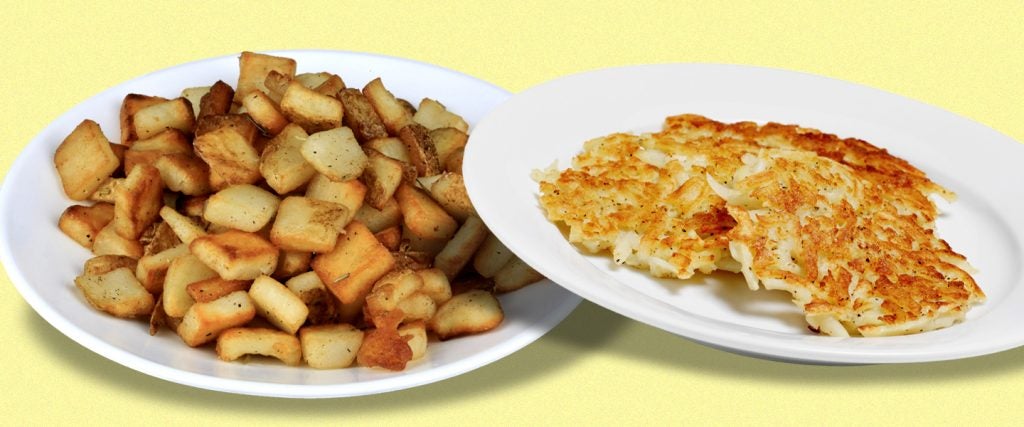Growing up in a seven-person household, meals were typically made in bulk. Almost every weekend, when breakfast was a shared meal, that meant two pounds of frozen hash browns frying alongside a row of eggs and sausages. In fact, for all the various forms of potato we consumed in that house, it wasn’t until much later in my life that I realized other forms of breakfast potato existed — a la home fries. Hash browns were always the go-to because they were cheap, frozen and easy to make in sizable quantities.
Besides, aren’t home fries the same thing anyway? And more largely, aren’t both home fries and hash browns just breakfast takes on french fries and tater tots?
Home Fries vs Hash Browns: Preparation
According to professional chef Lauren Kendzierski, it’s not so simple. “Hash browns and home fries are both partially cooked potatoes that get shredded and fried,” she says. “But how they’re prepared from there is where they split. Hash browns are basically just deconstructed tater tots, while home fries are boiled potatoes that have been cooled and diced, then sauteed until crispy.”
To really “maximize flavor and texture and get the most out of either dish, you have to put in some effort during the preparation,” says Shawn Matijevich, lead chef at the Institute of Culinary Education. When making them from scratch, “hash browns require equipment to produce those restaurant-quality long, fine shreds of potato, which can be done at home with a box grater,” he explains. “All those fine threads of potato add up to exponentially more surface area and that means more texture when it’s fried properly.”
Home fries, however, are a bit easier to make from scratch. “These can be made from leftover roasted or baked potatoes,” Matijevich says. “Even if you start from scratch, home fries require a bit less preparation — all you need is a knife to cut them and a pan to fry them.”
Home Fries vs Hash Browns: Taste
Despite not be prepared the same way, home fries and hash browns generally get confused because they’re used so interchangeably. “The difference largely depends on which part of the country you ask people,” says Matijevich. “Generally speaking, yes, home fries are diced potatoes and hash browns are shredded, but the beautiful thing about potato dishes is that they have a fairly neutral flavor and can be interchanged.”
For instance, both Matijevich and Kendzierski say you can’t go wrong placing home fries or hash browns “alongside most breakfast and brunch items” like omelets, eggs Benedict or “even on their own when combined with a delicious topping.”
That said, their flavor profiles do differ. “Hash browns are best as a patty and deep fried, like a giant smooshed tater tot, which makes them the more flexible of the two breakfast potatoes,” Kendzierski says. “You can use them to make a crust for a pie or use two hash-brown patties instead of bread for your sandwich for a great gluten-free breakfast hack.”
Home Fries vs Hash Browns: Nutritional Value
Speaking of gluten free, which form of breakfast potato is the most healthy (or better put, least unhealthy)? “Hash browns are definitely the less healthy option,” Kendzierski tells me. “Home fries are a bit more substantial so you eat less, and since they’re usually cooked with some onion and pepper, you up your nutritious veg count a bit.”
And if you’re sick of hash browns and home fries but still have a bunch of potatoes leftover for lunch, Kendzierski has you covered there, too. “Just slice the potatoes as round instead of a dice,” she says. “Now your home fries become the ‘chip,’ and perfect for Irish Nachos.”

